Heuvelop voor ligfietser zwaarder dan conventionele fietser?
Gepubliceerd op 27 maart 2012 23:34, bijgewerkt op 27 maart 2012 23:40
(3776 keer bekeken) 13![]()
Algemeen wordt aangenomen dat op een vlakke weg het rijden met de ligfiets voordelen heeft t.o.v. een conventionele fiets. Minder frontaal oppervlak geeft minder weerstand.
Al in 2009 opperde José Carlos Rodrigues Ramirez het vermoeden dat het mogelijk niet waar is, dat het een ligfietser meer moeite kost om een heuvel, laat staan een berg, te beklimmen. Maar ja, een bewijs is niet zo geleverd.
Afgelopen februari is er werk van gemaakt. Aanwezig zijn o.a. José Carlos, Fran Vacas (de man die vorig jaar 1.000 km binnen 31 uur af heeft gelegd: een wereldrecord!).
Conclusie
Op 25 februari 2012 rijden ze naar de berg Morcuera bij Miraflores de la Sierra.
Fran Vacas beklimt de bergpas twee keer, eerst met de ligfiets dan met de conventionele fiets. We zorgen er voor dat beide even zwaar zijn. Er wordt in één verzet, fixed gear, gereden die voor beide hetzelfde is, vanwege de verschillende configuraties! De fietsen gebruiken zelfs dezelfde wielen: dezelfde wrijvingscoëfficiënt!
Het vermogen wordt gemeten met de fiets vermogensmeter de ‘PowerTap’. Die bij de finish uitgelezen worden
Gebruikte fietsen:
- ligfiets: Metabikes Metaphysics
- conventionele fiets: Kuota
Beklimming 1 (ligfiets, gewicht 12,4 kg):
- Gemiddeld vermogen: 250 W
- Maximum vermogen: 371 W
- Maximum snelheid: 24,4 km/uur
- Gemiddelde snelheid: 13,9 km/uur
- Gemiddelde cadans: 55 t/min
- Afstand: 5 km
- Tijd: 21 min 09 sec
Beklimming 2 (conventionele fiets, gewicht 12,4 kg):
- Gemiddeld vermogen: 250 W
- Maximum vermogen: 389 W
- Maximum snelheid: 24,2 km/uur
- Gemiddelde snelheid: 13,9 km/uur
- Gemiddelde cadans: 52 t/min
- Afstand: 5 km
- Tijd: 21 min 07 sec
Dat is twee seconden verschil in het voordeel van de conventionele fiets! Te weinig om van een voordeel te spreken. De conventionele fiets legt, omdat die wat meer slingert, een iets grotere afstand af dan de ligfiets, hoewel de finishlijn op dezelfde plek ligt!
De testresultaten, bevestigt Jose Carlos conclusie zoals hij die drie jaar geleden gepost heeft op het Spaanse forum. En hij staat in die mening niet alleen, ook Bram Moens van M5 beweert dit al jaren.
Zijn er nog variabelen? Vermoeidheid, conditie, psychologisch.
Aanwezig: Fran Vacas, José Carlos en zijn vrouw Mari Carmen, Roberto, Edu, José en Juan.
In het Engels vertaalt, hier de originele Spaanse versie:
Comparison recumbent versus upright bike (power meter, ultra distance, measurements, mountains pass… and more! part ii)
A short fable
Once upon a time a cyclist father gave his 12 years old twin boys each a different bike: one of them a recumbent bike and the other an upright bike. The reason for this crazy decision is beside the point.
Initially, each child envied the bike provided to the other by their father, but over time, good food, training together and separately, it ended that they were delighted what the bike was bringing them, which was given by chance.
The bikes weigh the same; have the same color, the same wheels, similar chain wheels and development of sprocket blocks. They were identical except for the geometry! Physically / metabolically both grew stronger, under the same conditions of feeding, training hours, days of rest, vitamin supplements and many more, which are well known for training on a bike.
Their father was responsible for monitoring that both train equally and that under no circumstances they try out the benefits of the other bike in addition to their own. Neither train on the other bike.
Questions of purists
Over time, the fame of the biking couple grew throughout the kingdom, particularly given the marked difference compared to the other. This duo was unique and worth seeing. So one day, the king of that land, called the father with his two sons, and asked a simple question:
Which bike climbs better?
And here the story ends, because in those days there were no power meters in the kingdom and all was postponed for ever and ever, until last Saturday… (February 25, 2012, Ed.)
***
Preparations for an ascent with a recumbent (and an upright) bike
It’s Saturday morning 7 o’clock on February 25, 2012, and I put all my gear in a large backpack: tools, extra heavy, drinks, lightweight pedals, tie wraps… and mentally review the condition on the recumbent bike Metaphysics and other accessories needed for the test. I realize I’ve forgotten to ask a friend for the scale, but José Carlos (expert in the performance analysis of the recumbent versus the conventional from the ‘Foro de Reclinados de España’ - the Spanish Recumbent Forum) is in Madrid to assist with the test and I call him to find out if we can achieve this with what we weight ourselves.
The day before, José Carlos wrote me a short email, telling me that at the last minute he and his wife (Mari Carmen) had decided to join the performance test with Fran Vacas. A little madness, in truth, they come from Coruna for only a couple of hours for the tests that could well have done there. But the biker scene is like this: we are committed to facts that we have faith in. La cordura, para luego. Quiero decir, el cordero (translation makes no sense, Ed.).
“Got the scale”, José Carlos told me in a SMS and I’m calmer.
Along with the Metaphysics, there is also a StreetMachine Gte, which José Carlos was riding during the test. It’s a quarter past eight, so I’m heading to Miraflores de la Sierra without any further delay. By the way, riding on the bike path in Colmenar Viejo, and at the height of Tres Cantos, I see two bentriders also towards Morcuera. They are Edu and Roberto, who left Plaza Castilla at 7:30. This should take some time, because the fitness of Roberto and Edu is such as it should be at the level of Colmenar Viejo. They are the typical riders, well known at the local brevets of Madrid.
I leave them and concentrate on the track and it takes me 45 minutes to get to Miraflores de la Sierra. Just before reaching its destination, I see Fran in front of me fastening pedals, and I park the car to greet him. He rides with an upright bike that weighs like a feather, white and accentuated cycle power meter ‘PowerTap’ wheel in the frame. I’ll take his backpack and it took me 5 minutes to find a path to the foot of the ascent of the Morcuera.
Finally the scale did arrive… Meanwhile, we changed the wheels from the “light weight” to the recumbent. The choice which bike has to go up first is at random. We realize that the chain wheels are different. The Metabikes has a Shimano Sora triple 53-42-30 and a smaller chain wheel than the upright: 39T (so, different chain wheels here). However, the disadvantage is easily solved: on the recumbent with its chain wheel 42T with sprocket 23 and the upright bike with the chain wheel 39T and a sprocket 21. The formula amount to fixed gear is reinforced with the chosen configuration. The latter is one of the conditions of the test: to climb without gear changes.
We take photographs of the process, recorded in the first test data on the mobile phone, José Carlos and family arrive, and we review the premises…
***
Conditions of the comparison
We are getting a little technical:
- Two climbs: first the recumbent, then the upright.
- Ascending 5 kilometers (identical route), stopping the bike where it is connected and collect the ‘raw’ data.
- Maintain 250W continuously on the two climbs.
- There will be no gear changes: fixed gear mode for both climbs.
- Weight is identical.
- The same coefficient of friction on the wheels (comparable).
With these thoughts in mind, there was only to perform them as close as possible. Maintaining 250 W stable during the ascent of a mountains pass, is not easy. Perhaps more difficult than in a flat or a downhill, but the goal is to hold the same workload, for 20 minutes in a controlled manner, during each ascent. This is the section where Fran have to focus more than anything else.
***
The ascent
Along with José Carlos, Mari, José and Juan, the scale arrives, and Fran continues with the recumbent despite the differences to obtain a weight of 12.4 kg. To compensate for the upright bike, an extra 3.5 kilos is added to it (this is for the second ascent).
Small story, I have to tell that with these cold hours, the scale (or rather their batteries) did not feel to work at all. Fortunately, the batteries from José’s computer were the same size as in the scale and we breathe once more relaxed, given the importance of the test. Keeping power, albeit in a scale, is not an easy task.
While José Carlos adjusts the StreetMachine, Fran resumes with the recumbent, recalling the two thousand kilometers he already made three months ago. At first with some hesitations, and after a few laps, more self-confident. At this time Roberto and Edu, who made presentations, arrived and were discussing the details of the ascent. Little festive atmosphere to see four recumbents together in the middle of the ‘Sierra de Madrid’.
This is where we note that Fran would not climb the entire mountains pass, as 5 km would be sufficient for the measurements, it will make little excessive to perform a second ascent. Meanwhile, the others decided that they would climb the entire mountains pass on their recumbent and upright bikes.
Continuing the test, we aim to consider the developments in each ascent, and with this in mind we focus on fine-tuning the recumbent to the size of Fran. When made the adjustments, we are located at the starting point (just before the ascent on the Morcuera).
During this time, Roberto suffered a regrettable mishap with a driver who knows little of cycling and tolerance in a place where cyclists of all sorts abound and where most of the time there is a good understanding. But Roberto has been taken the act of a personage that park and comes running through a screaming group. That said, an unfortunate morning.
There are Edu and José Carlos, also the city police, when Fran starts we follow him ascending very slowly, continue to do some photos and accompany him till the end of the course. Roberto with his Seiran quickly hooked up and although he lags behind for a while, a couple of curves later and would be be first, in his own words “giving everything”. Fran focuses on the recumbent Metabikes.
We are making several stops to photograph Fran, Roberto and Juan who are more or less together decided to climb to the point of arrival, where we reach José to go first in the ascent with his mountain bike. We stayed there just until Fran arrived; we collect the data and going down to the starting point.
We change the wheels from the recumbent to the upright bike, and during that time many interested people ask about the test, the recumbent and the usual question arises of the benefits they offer. If you know that we are here just to show that, it is still nicer, in addition to flat or downhill.
Which gives us more time to adjust the exact weight to be added to the backpack to take Fran during the second ascent. We tried a big bottle Aquarius, but the account goes on to be drinking 1 whole liter to adjust the weight. And Fran, although he has some thirst, is not eligible for drinking one liter or even a medium. I would have to carry it! So I begin to drink, to reduce a half liter… only there is still a half left!… Roberto arrives, who at this time has been on the mountains pass, and accepts a glass of water. Given the choice, we have some other things to do and decided to remove the backpack and the weight block from the scale for the first ascent. All set, and go!
The second ascent, Fran made with no other companion than our car and the clicking from the photo’s Mari is taking, as the rest of the group is climbing onto the mountains pass, except for Roberto who is waiting in Miraflores. We decided to decrease the number of photos and stops (from which we already had a lot!), and wait for Fran to finish the virtual 5 km. Where the bike is stopped, we went and collect the new data. The conclusion is immediate: “It has been the same, up on recumbent and the light weight.” We aim for accuracy for data. Peak power, average power, average speed, maximum speed, time, cadence…
What remains is to collect and sort the data. We discuss the results amongst us all, on a sunny terrace while drinking a coffee, a beer and eat some snacks. Some have to go home for a lunch. So, the goodbye will be short and very friendly. Meanwhile, seeing the recumbent bike and Fran, do many other cyclists, triathletes stop to say hello and to make some comments on his new bike. By now we see that for an amateur cyclist, who didn’t see something like this before, an upright carbon bike is better than a new ultra-lightweight recumbent, weighing 12.4 kg. It is the same reaction we had in the Paris-Brest-Paris at the carbon models of Velokraft, M5 or Zockra.
So, Edu and Roberto say goodbye and return to Madrid on their recumbents (oddly enough, we would see them again on Tres Cantos, not far from here), Fran also returned after pedaling to his house on his new bike, José Carlos, Mari, Jose and Juan were staying in the Sierra to enjoy the typical dishes and your writer went back to the place where the bikes are during the test.
Needless to say that, as in a good company, we wanted to stretch the day as much as possible and personally we regretted not having given a single pedal stroke through the Sierra during the test. There will be other occasions later in May, near the green-way Tajuña in the annual recumbent meeting organized in Madrid: the RecliMAD (May 24th-25th open to others Europeans recumbent riders! - added, Ed.).
And now, the conclusions…
***
The results
So, we have extended comparative description of all we wanted to get here. That’s why there were two ascents. The truth is that we are not that technical, not as stringent as we would like to be and we like to share what has occurred, in the manner we comment every day at the recumbents and its performance. That on an informal tone, but as substantiated as possible. There is little to argue, just the advantages of recumbents on the flat and downhill, but there is always the pitfall of the comment on its performance on an ascent. Personally, I like the dynamic that accounts for some debates, that’s the debate itself. But once the data is collected, it is easy to surrender to the analysis and consider the attempt to cross them with other variables.
Consider the data collected in the two tests carried out by Fran Vacas:
Ascent 1 (on the recumbent, weight 12.4 kg):
- Average power: 250 W
- Maximum power: 371 W
- Maximum speed: 24.4 km/hr
- Average speed: 13.9 km/hr
- Average cadence: 55 rpm
- Distance: 5 km
- Time: 21 min 09 sec
Ascent 2 (on the upright, weight 12.4 kg):
- Average power: 250 W
- Maximum power: 389 W
- Maximum speed: 24.2 km/hr
- Average speed: 13.9 km/hr
- Average cadence: 52 rpm
- Distance: 5 km
- Time: 21 min 07 sec
As experts say, a Watt is a Watt, and no one can deny that. With the same Watts supplied, the differences are minimal: just 2 seconds of difference for each ascent. And it is worth to state that, although the bike has stopped at the 5km indication, the upright rode a few meters more than the recumbent. This is because Fran and the lightweight (upright) is doing more zigzags in respect to the recumbent. This, though not relevant for this test, leaves us the inaccuracy in which we may incur when we make comparisons about the longer distances, with differences of minutes or larger distances.
The test results, reaffirms José Carlos conclusion, three years ago, drawn by the comparison and posted on the recumbents forum in Spain with the news, that now it has been measured more accurately with the power meter, that the conditions of both bikes are matched by using the same wheels.
It is also important to point out that this test is as homologous as those that may have be made earlier by other recumbent bikers in the various countries. As is in the case of Bram Moens from the Netherlands, founder of m5 and who has always presented opposition against the upright cyclists with remarkable success, to emphasize the advantages and disadvantage of non-recumbent against the conventional bike.
With the data in mind, we leave you now, but not before sharing a couple of links that help you to exploit more information. These are (both in Spanish):
Introduction to training by Watts.
Difference between training by heart rate and Watts.
There are and will be, data and analysis.
***
A number of thoughts after the test
During the return, and after a day or so, our ideas are as follows…
(1)
We like the conclusion.
Nowadays, the recumbent is usually taken for the lack of possibilities to obtain in a similar way on an upright bike. It is an issue that holds in the perceptions and intuitive in the statistics: most recumbent bikes weigh more than a conventional bike. It is also true; there are a minority of recumbent carbon bikes on the road. In the market, there are recumbent bikes of 7, 8 and 9 kg. We’ve seen and tested them at the Spezi, CycleVision and in the Paris-Brest-Paris 2011 (PBP). Parallel for this point, it’s about the physical shape of the cyclist, also for statistics on a mountains pass, people with a large stamina, we recumbents are a minority.
Joining the two concepts: there are few recumbent cyclists with a light bike fit enough to climb.
But what happens when you have a light recumbent and a high-physical training?
However, don’t forget that we only want to compare at similar conditions. The struggle is to argue for the benefits of recumbents as we did this will not undo a statistical perception. Although subsection worth that most of the recumbent riders, we saw participators in the PBP2011, had some fantastic and exceptional physical condition plus relaxed.
(2)
Moreover, the result gives us a sharp line can run across to most of the other subjective variables: fatigue cyclist, comparison of the heart rate, anaerobic/aerobic condition, heart strain. If you provide incentives to improve the reality on the recumbent cyclist, then they are welcome. Learned from an empirical debate where we must be clear that each cyclist has individual conditions: self generated cadence, heart rate can vary with only a couple of hours sleep less or just having a bad day… and many more.
And then the factor “psyche” of the rider, there is no doubt but that is almost not provable. We have only circumstantial evidence as Fausto Coppi had the custom of removing the water bottle from his bike and spill it on his jersey (with no effect on the total weight), just before he attacks the harshest mountain passes in the Giro D’Italia, just in the assumption that he has to be light weighted on the bike, so giving him wings. Is Coppi seated comfortably on a recumbent spilling the content of the water bottle on his jersey?
(3)
In particular, we are left with the itch to turn over the bike and perform tests on a long distance downhill, with full fairing, part in the front or part in the back. In the future we will realize the tests, if we have the means… to start where our velomobile ticking an unthinkable time when the road is going a little downwards.
(4)
Last idea: completed the test, and in the absence of the two brothers with the bikes from the fable, we are left only with our upright and recumbent bike and doing heavy workouts. Up and up, although it’s hard for the recumbent cyclists, a thank you for the background it provides. Finding the proper cadence is a matter of time. Also the (sit) position and knowing when to go for the upright or for the recumbent. Eating right, work out on tempo, particular when we establish specific routines with the recumbent. All aimed at improving our performance… and matching us with the conventional bike?
The truth is that many do not even consider this self-demands, as they seek to enjoy and suffer at random on their comfortable seat.
***
The fable conclusion
The child with the upright bike, shifts the handlebars, changed the strength, was made with a carbon fiber second-hand seat and built his own recumbent bike.
Ever since the two brothers are talking amicably downhill, on the flat… and, as always, uphill!
***
Thank you for following this long story of ideas about recumbents and conventional bikes, including data, numbers, theories and to open to all constructive contributions and knowledge bases. I hope to have the same spirit in an upcoming trial and again an everlasting thanks to Fran Vacas and his positive willingness for these tests on a recumbent bike. It’s a luxury to have their points of view, resources and experience between the regular discussions of recumbent cyclists in Spain.
You can see more detailed photos from that day, in the album of Okocicle.
Greetings to all!






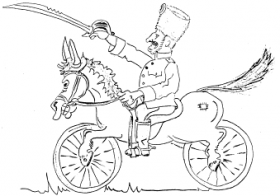
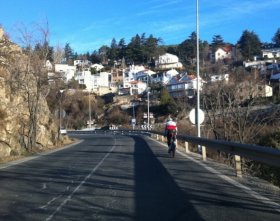
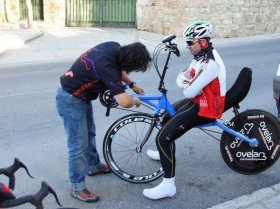
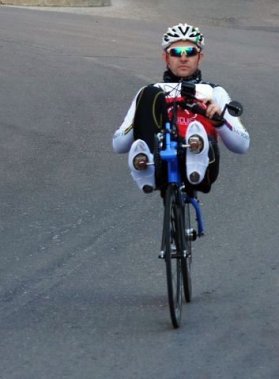
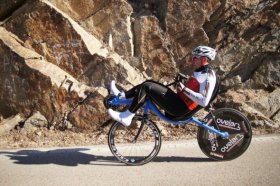
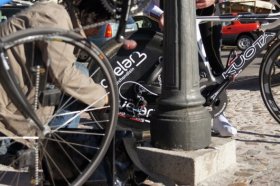
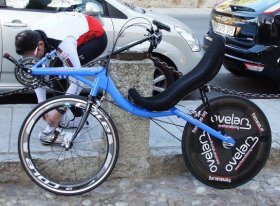
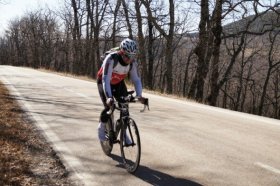
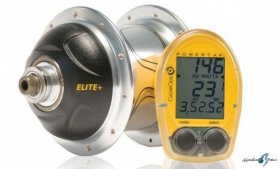
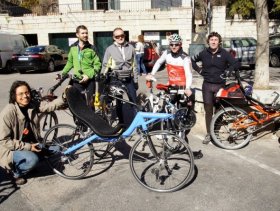

Reacties (13)
Nogal wiedes dat twee dezelfde gewichten bij gelijk geleverd vermogen even snel bovenop een berg zijn. Gemeten had moeten worden wat de toptijd was van dezelfde fietser met race- danwel ligfiets. Mijn aanname is dat je op de ligfiets een beperkt assortiment spiergroepen aanspreekt. Door specifieke training kun je deze spiergroepen zo sterk maken dat hart-long de beperkende factor wordt. Daarmee valt het klimnadeel van de ligfiets weg.
wakkermans, 28 mrt 2012 00:25
Dit is niet verrassend. Het probleem zit hem in het *leveren* van datzelfde vermogen. Voor mijn gevoel is dat moeilijker op een ligfiets.
Maar misschien heeft Ymte wel gelijk en lijkt dit zo omdat ik op het vlakke voordeel heb tov racefietsers dat bergop wegvalt.
Sake, 28 mrt 2012 12:30
Ik heb een ligfiets gemonteerd op een tacx met vermogensmeting (fortius. Voorheen gebruikte ik hier een racefiets voor. Ik ben nu twee jaar geleden overgestapt van trainen op een racefiets na trainen op een ligfiets. Ik kan wel zeggen dat ik nu nog steeds niet even veel vermogen kan trappen op een ligfiets als voorheen op de racefiets. Vooral het eerste jaar is het verschil erg groot. Vooral bij een vlakke stoel (nu 11 graden) is het moeilijker om hetzelfde vermogen te trappen.
Met de ligfiets train ik nu iets meer dan voorheen met de racefiets.
Wel is het zo dat bij een tacx het vermogen op de achterwiel wordt gemeten en niet op de crancks. De aandrijflijn bij een racefiets is efficienter dan die van de ligfiets.Het zou dus kunnen dat op dit moment mijn vermogen op de crancks hetzelfde is als een paar jaar geleden bij de racefiets.
In deze test zal de ligfiets misschien nog wel wat aerodynamisch voordeel hebben gehad en de racefiets voordeel van de betere aandrijving. Blijkbaar kunnen deze twee voordelen in deze test tegen elkaar worden weg gestreept.
Math, 28 mrt 2012 14:56
Fijn om te lezen dat de wetten van de fysica het nog steeds doen. Had altijd al de indruk dat daar niet aan te tornen viel, zelfs niet aan de bar van de wielervereniging.
walter, 28 mrt 2012 22:24
Ben ik de enige die het vreemd vindt dat bij "een gelijk verzet" en een exact gelijk gemiddelde snelheid (13,9km/h) de rechtopfiets een cadans van 52rpm had, maar op de ligfiets 55rpm? Dat kan fysiek niet (bahalve bij wielspin haha)... Dus het verzet zal toch verschild hebben. Maar goed, een Watt is een Watt, of die nou bij 50 of 100 rpm geleverd wordt.
Overigens zijn er naast (in dezelfde prijsklasse) verschillend gewicht tussen een lig- en racefiets nog een paar belangrijke verschillen:
- Bij een racefiets kan je stukken gaan staan, wat dieper of juist rechter gaan zitten. Dit geeft een andere spierbelasting (en helpt ook psychologisch).
- Bij een lowracer heb je meestal een of meerdere kettingrollen die toch iets van je aandrijvingsrendement afsnoepen. Bij 250Watt en lage snelheden (geen aero-voordeel) is een paar procent verlies al snel merkbaar. Bij Highracers heb je dit nadeel in de regel veel minder, omdat de kettinglijn rechter is.
- Een ligfietsframe is in de regel veel minder stijf dan een racefietsframe. Hierdoor komen Watts bij de crank op de racfiets met minder verlies bij het achterwiel dan bij een ligfiets. Zeker bij een lage cadans (en zwaar aanzetten) telt dit op. Ook dit is bij een lowracer een groter 'probleem' dan bij een highracer, want het frame van de highracer is in de regel ook 'rechter' dan dat van een lowracer.
Verder is het een mooie test, maar er wordt zoals Sake al meldt niets gezegd over de 'moeite' die de rijder moet doen om een bepaald vermogen te trappen. Wat ik graag had gezien was bijvoorbeeld een hartslagmeting ernaast! Hierover is wel al veel onderzoek gedaan, en het heeft niet zozeer met de lichaamsorientatie te maken (hele lijf vlak/rechtop) maar wel met de hoek benen/rug (gebukt of gestrekt). Meer gebukt= 'makkelijker' meer watts trappen dan gestrekt. Dit past in het heersende gevoel dat je voor een flinke klim je stoel meer rechtop zou moeten zetten.
A.vanLent, 29 mrt 2012 09:38, bewerkt op 29 mrt 2012 09:42
@Arent-Jan Het is precies andersom: Gestrekter lichaam betekent meer vermogen: http://journals.humankinetics.com/jab-back-issues/jabvolume17issue3august/anaerobiccyclingpoweroutputwithvariationsinrecumbentbodyconfiguration
Dit is een belangrijke reden waarom een racefiets zo'n slechte klimmer is. Lage en hoge racers zijn ook geen supergoede klimmers, met name omdat het bracket te hoog zit waardoor je je buikspieren gaat aanspannen.
Er is nog veel meer over te zeggen, maar dat doe ik in een artikel waar ik op dit moment aan werk. Mijn conclusie is in ieder geval dat met een goed ontworpen klimligfiets en de juiste techniek de ligfiets de beste klimmer is. Zoveel beter dan een bukfiets dat je een paar kilootjes extra prima kunt lijden.
walter, 29 mrt 2012 10:50, bewerkt op 29 mrt 2012 10:53
Een paar jaar geleden, Mike Burrows heeft bijna hetzelfde experiment gedaan met dezelfde conclusie. Het was in een BHPC newsletter.
Het is altijd goed een bevestiging te zien.
davidhembrow, 29 mrt 2012 20:29
@David, heeft Mike Burrows zijn test gedaan met de vermogensmeter in het wiel of in het crankstel? Daaruit zou je iets op kunnen maken over de invloed van verliezen in de aandrijving en het frame.
walter, 29 mrt 2012 21:08
Walter, ik denk hij gebruikd alleen hartslag. Ik heb de artikel niet online gevonden. Ik denk ik heb de newsletter... maar waar ?
davidhembrow, 29 mrt 2012 22:11
Gemiddelde snelheid (13,9km/h) de rechtopfiets een cadans van 52rpm had, maar op de ligfiets 55rpm betekent dat ... aandrijving van de ligfiets was niet gelijk efficient als aandrijving van de racefiets. En dat is typisch voor bijna elke ligfiets met lange ketting. Gellukig was er een vermogensmeter gebruikt.
MaciejDlugosz, 30 mrt 2012 19:16
52 of 55 rpm voor de cadans bij dezelfde snelheid is (vrijwel) de verhouding tussen een 26 of 28 inch wielmaat. Ik denk dat de ligfiets een net iets kleiner wiel had, maar dat ze alleen naar de tandwielen hebben gekeken bij het bepalen van het verzet. Slordig.
MaartenSneep, 30 mrt 2012 23:50
@Maarten: dat was geen slordig testje. Er waren hetzelfde wielen gebruikt. Probeer jezelf een ligfiets en daarna en conventionele fiets met een vermogensmeter en cadansmeter. En denk over fietsen die wereld recorden kunnen zetten. Welke type van aandrijving is zo efficient als mogelijk?
MaciejDlugosz, 01 apr 2012 12:42
Als je met hetzelfde verzet rijdt, met dezelfde cadans, dan ga je onherroepelijk even snel, ongeacht de efficiëntie van de aandrijving. Een minder efficiënte aandrijving wil niet zeggen dat er ineens rek in de ketting zit. Daar klopt echt iets niet.
En met verzet bedoel ik hier het aantal meters voortgang per omwenteling van de trappers, voor alle duidelijkheid.
MaartenSneep, 01 apr 2012 22:12